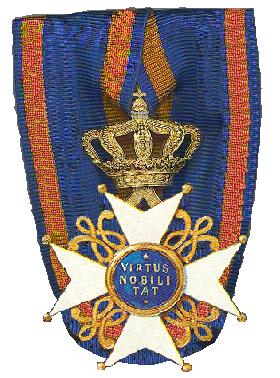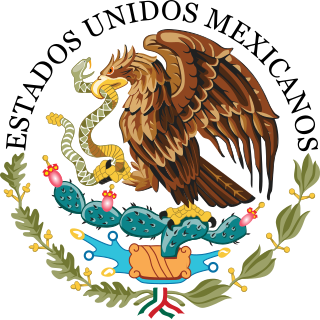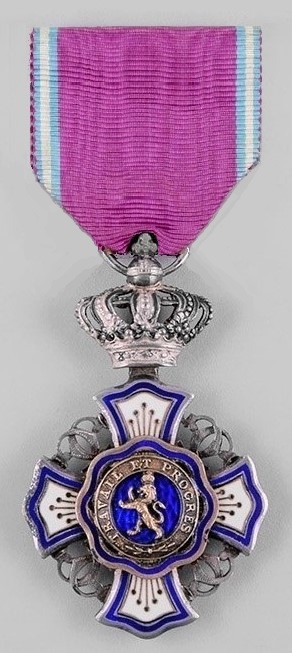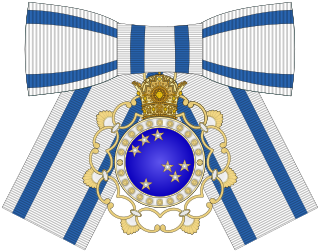
The Order of Orange-Nassau is a civil and military Dutch order of chivalry founded on 4 April 1892 by the queen regent, Emma of the Netherlands.
The Ordre des Arts et des Lettres is an order of France established on 2 May 1957 by the Minister of Culture. Its supplementary status to the Ordre national du Mérite was confirmed by President Charles de Gaulle in 1963. Its purpose is the recognition of significant contributions to the arts, literature, or the propagation of these fields.

The Order of the Netherlands Lion, also known as the Order of the Lion of the Netherlands is a Dutch order of chivalry founded by King William I of the Netherlands on 29 September 1815.

The Royal Order of the Sword is a Swedish order of chivalry and military decoration created by King Frederick I of Sweden on 23 February 1748, together with the Order of the Seraphim and the Order of the Polar Star. The motto of the order is in Latin: Pro Patria.

The Royal Norwegian Order of Saint Olav is a Norwegian order of chivalry instituted by King Oscar I on 21 August 1847. It is named after King Olav II, known to posterity as St. Olav.

The Order of Civil and Military Merit of Adolph of Nassau is an order of merit of the Grand Duchy of Luxembourg for meritorious service to the Grand Duke, the Grand-Ducal House and Luxembourg. It was founded in 1858 as a chivalric order of the Duchy of Nassau by Adolphe of Nassau in honor of his namesake and ancestor, Adolf, Count of Nassau, the only member of the House of Nassau to have been Roman King of Germany. After the Duchy of Nassau was annexed by Prussia in 1866 and Adolphe became Grand Duke of Luxembourg in 1890, he revived the order as an order of merit.

The Royal Order of Vasa is a Swedish order of chivalry, awarded to citizens of Sweden for service to state and society especially in the fields of agriculture, mining and commerce. It was instituted on 29 May 1772 by King Gustav III. It was unrestricted by birth or education and could therefore be awarded to anyone. It was the most junior of all the Swedish orders. It was often awarded to Norwegian subjects of the dual monarchy until Oscar I founded the Norwegian Order of St. Olav in 1847. Previously considered dormant from 1974, the order has again been active since 1 February 2023.

The Royal Order of the Polar Star is a Swedish order of chivalry created by King Frederick I on 23 February 1748, together with the Order of the Sword and the Order of the Seraphim. The Order of the Polar Star is intended as a reward for Swedish and foreign "civic merits, for devotion to duty, for science, literary, learned and useful works and for new and beneficial institutions".
The Order of Grimaldi is an Order established in Monaco on 18 November 1954.

This is a list of military decorations awarded by the United Mexican States as part of the Mexican Honours System.
The Order of the African Star was established by Leopold II of Belgium on 30 December 1888, in his capacity as ruler of the Congo Free State, and was awarded for services to Congo and for the "promotion of African civilisation in general". It was incorporated into the Belgian honours system on 10 October 1908 following the annexation of the Congo Free State by Belgium. The motto of the Order is "Travail et progrès". The King of the Belgians is its Grand Master; although the Congo is no longer a Belgian colony, it is still considered to be a Belgian Order by tradition.

The Royal Order of the Lion was established by King Leopold II of Belgium on 9 April 1891, in his capacity as ruler of the Congo Free State, and was awarded for services to the Congo and its ruler that did not deserve the award of the Order of the African Star, and were not necessarily performed from within Belgian Congo.

The Order of the Colonial Empire was a Portuguese Order (decoration), established on 13 April 1932 as a colonial order of knighthood, to reward services by soldiers and civilians in the Portuguese colonies in Asia and Africa.

The Order of the Pleiades, also named Order of Haft Paykar, was an all-female order of the former Imperial State of Iran.

The Honorary Order of the Yellow Star is the highest state decoration of the Republic of Suriname. The Order was instituted in 1975 at the independence of Suriname and replaced the Dutch Order of the Netherlands Lion. It is awarded to individuals for their meritorious service to the Surinamese people or nation. Foreigners are also eligible to receive the order. The president of Suriname is the Grand Master of the order.

The Royal Order of the Crown of Tonga is an Order of Merit awarded for exceptional services to Tonga and the Crown of Tonga.
The Royal Order of Pouono is the highest order of chivalry in the Kingdom of Tonga.

The Most Illustrious Order of Queen Sālote Tupou III is a knighthood order of the Kingdom of Tonga.
The Order of the Leopard is a merit order of the former Republic of Bophuthatswana. The Order was instituted in order to recognise service to the people of the Republic of Bophuthatswana. It was instituted by the President of the Republic of Bophuthatswana by official Warrant on 28 December 1979.
The Order of Ivory Merit is the second highest honorary order of the Ivory Coast created in 1970, and is intended to reward distinguished merits acquired in a public, civil, military or private function.














